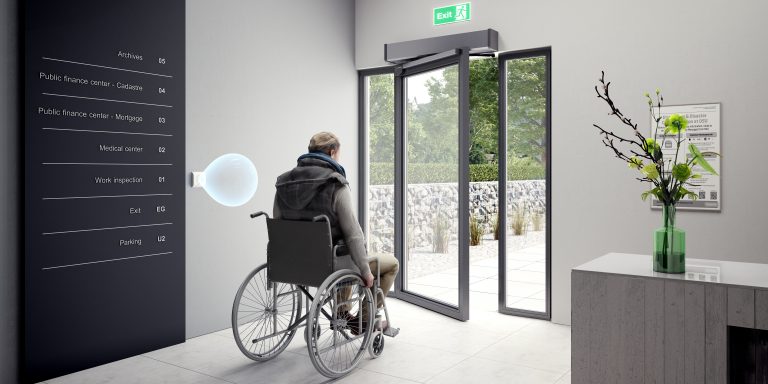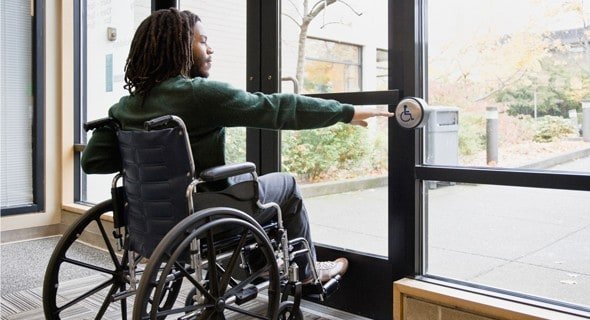Automatic Doors for People with Disabilities
Automatic doors play a crucial role in enhancing accessibility and improving the quality of life for people with disabilities. By eliminating the physical barriers posed by traditional doors, automatic systems offer increased independence, convenience, and safety. This article delves into how automatic doors can make daily life easier for people with disabilities, the types of automatic doors available, their key features, and the importance of designing inclusive environments.
Challenges Faced by People with Disabilities

For many people with disabilities, traditional doors pose significant challenges. Manually opening doors, especially heavy ones, can be difficult for individuals who use wheelchairs, have limited strength or mobility, or experience other physical impairments. Navigating narrow doorways or trying to handle traditional doorknobs can make access even more difficult. These barriers limit independence, restrict access to public and private spaces, and contribute to feelings of exclusion.
How Automatic Doors Improve Accessibility

Automatic doors offer a solution to these challenges by providing hands-free access to buildings, rooms, and other spaces. For people with disabilities, this means they can navigate through spaces without needing assistance, contributing to a greater sense of autonomy. Here are some of the key ways automatic doors benefit individuals with disabilities:
- Ease of Use: Automatic doors open and close without requiring physical effort. Sensors or buttons can trigger them, eliminating the need to push or pull heavy doors.
- Wheelchair Accessibility: Wide, unobstructed automatic doors are ideal for wheelchair users, providing sufficient space for easy passage. Additionally, the lack of thresholds or uneven surfaces reduces the risk of accidents.
- Mobility Support: For individuals who rely on mobility aids such as canes, walkers, or crutches, automatic doors remove the challenge of balancing while opening a door. This ensures that movement is smooth and safe.
- Reduced Risk of Injury: People with limited hand strength or dexterity may struggle with turning traditional door handles. Automatic doors, which do not require physical manipulation, prevent strain or injury in such cases.
- Hands-Free Operation: Many automatic doors operate through motion sensors or touchless controls, offering a hands-free solution for people who may have difficulty using their hands or arms.
Types of Automatic Doors for Improved Accessibility

There are several types of automatic doors that are designed to improve accessibility. Each type has unique features that cater to different needs and spaces:
- Sliding Doors: Sliding automatic doors are common in commercial and public buildings. They open by sliding horizontally, offering wide, unobstructed entryways. This type is highly suitable for people in wheelchairs or those who use mobility devices, as it provides ample space.
- Swing Doors: Automatic swing doors operate by swinging open and closed, similar to traditional doors. They can be programmed to open with the push of a button, via a motion sensor, or through voice control. Swing doors are often found in hospitals and schools, making them practical for individuals with physical limitations.
- Folding Doors: These doors are ideal for spaces with limited room. Folding automatic doors provide wider access in narrow spaces, making them suitable for smaller entrances while still providing the convenience of automation.
- Revolving Doors with Automated Features: Though revolving doors may seem impractical for people with disabilities, many modern systems feature automatic modes. These doors can slow down or stop entirely for easier access, and some even feature integrated accessibility functions.
Key Features of Automatic Doors for Accessibility
To ensure that automatic doors fully cater to the needs of people with disabilities, they come equipped with several essential features:
- Motion Sensors: Motion sensors detect when someone approaches and automatically open the door, making it ideal for individuals who cannot manually operate a door handle or button.
- Push Button Controls: Push buttons, often placed at wheelchair height, allow users to easily activate doors when needed. These buttons are simple to use, requiring minimal pressure or dexterity.
- Low-Energy Systems: Automatic doors for accessible use are often equipped with low-energy mechanisms that control the speed and force of the door’s movement. This ensures that doors open gently and safely, reducing the risk of accidents.
- Voice-Controlled Entry: Some automated doors can be integrated with voice-command systems, allowing users to open doors with verbal commands, further enhancing ease of use for people with severe physical impairments.
- Access Control Systems: Automated doors can also be integrated with access control systems, providing a secure yet accessible way for individuals to enter private or restricted spaces. Systems like keypads, card readers, or facial recognition ensure that only authorized individuals gain entry without the need for manual locks.
Automatic Doors in Public and Commercial Spaces
In many public spaces, businesses, and commercial environments, automatic doors are a key feature in making the premises accessible to everyone, including individuals with disabilities. From shopping centers and hospitals to government buildings and airports, the presence of automatic doors reflects an organization’s commitment to inclusivity.
- Legal Requirements: In many countries, including Australia, the United States, and parts of Europe, building codes and disability acts require that public spaces be accessible to people with disabilities. Automatic doors are often a fundamental aspect of meeting these legal requirements.
- Inclusive Design: Beyond legal requirements, businesses and public facilities that prioritize inclusivity benefit from improved customer satisfaction. People with disabilities are more likely to visit spaces that are easy to navigate, and they often become loyal customers when they feel valued.
- Emergency Access: In public buildings, automatic doors also play a vital role in emergencies. In the event of a fire, automated doors can be programmed to open to provide a clear exit path. These systems can be paired with smoke detectors or alarm systems, ensuring rapid and safe evacuation for everyone, including individuals with disabilities.
Automatic Doors in Residential Settings
While automatic doors are more commonly associated with public buildings, they are also gaining popularity in residential settings. For individuals with disabilities, having automatic doors installed at home can make daily activities much easier. Here’s how:
- Independent Living: Automatic doors in residential spaces allow people with disabilities to move freely within their homes without the need for assistance. Whether entering or exiting the home, navigating different rooms, or accessing outdoor spaces, automated doors provide a newfound level of independence.
- Customized Home Automation: Many home automation systems now include automatic door controls as part of their suite of accessibility solutions. These doors can be connected to smart home devices, allowing users to control their doors via voice commands, smartphones, or remote controls.
- Safety Features: In residential settings, automated doors can be equipped with additional security features such as doorbell cameras, intercoms, and automated locking systems, offering both convenience and peace of mind for individuals with disabilities.
Designing for Accessibility: A Broader Perspective
Automatic doors are an integral part of designing accessible environments, but they are just one element of a larger picture. To truly create inclusive spaces, architects, designers, and developers need to consider all aspects of accessibility:
- Accessible Entrances and Pathways: Automated doors should be accompanied by ramps, wide pathways, and other accessible features to ensure that people with disabilities can easily navigate the space.
- Barrier-Free Design: Beyond just the entrance, the entire layout of a building should be designed to minimize barriers. This includes accessible bathrooms, elevators, signage, and seating areas.
- User-Centric Approach: When implementing automatic doors, it’s essential to consider the needs of a wide range of users. This means taking into account individuals with different types of disabilities, as well as older adults or people carrying heavy items, all of whom benefit from automated entryways.
Conclusion
Automatic doors significantly enhance the lives of people with disabilities, making homes, public spaces, and businesses more accessible and inclusive. By offering easy, hands-free access, reducing physical barriers, and integrating with other smart systems, automatic doors enable greater independence and mobility. As technology continues to evolve, these systems will only become more effective and essential in creating accessible environments for all.
Incorporating automatic doors is not just a convenience—it’s a commitment to inclusivity, safety, and dignity for people with disabilities, allowing them to live more independent and empowered lives.
